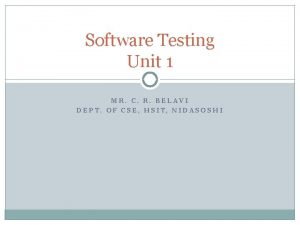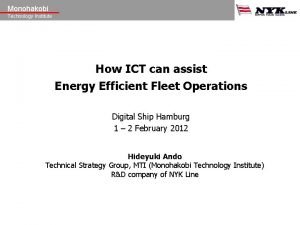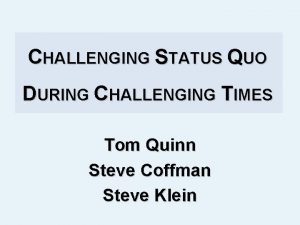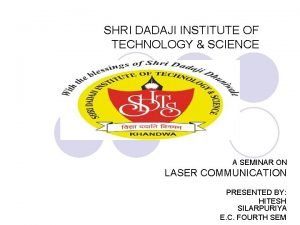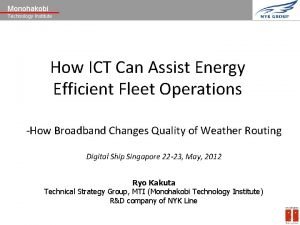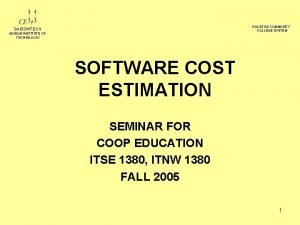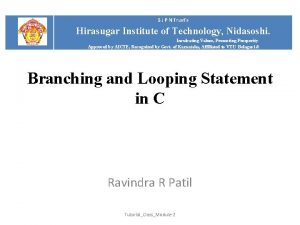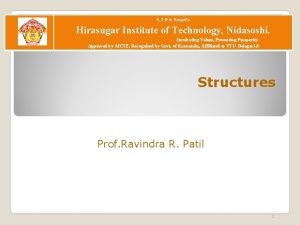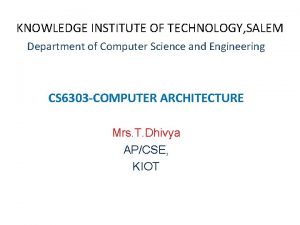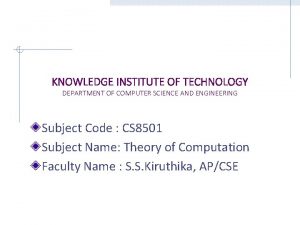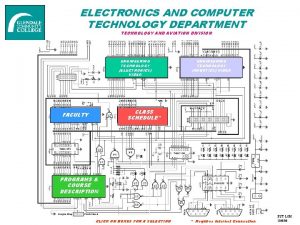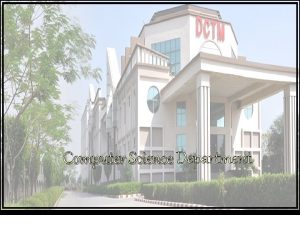Hirasugar Institute of Technology Nidasoshi Department of Computer





































- Slides: 37

Hirasugar Institute of Technology, Nidasoshi Department of Computer Science & Engineering ICT [Information and Communication Technology] Material on Management & Entrepreneurships for IT Industry (15 CS 51) 2018 -19 Odd Semester Dr. Parashuram Baraki Professor & HOD Dept of CS&E

Module 3 : Entrepreneur • meaning of entrepreneur, characteristics of entrepreneurs, classification and types of entrepreneurs, various stages in entrepreneurial process, role of entrepreneurs in economic development, entrepreneurship in India and barriers to entrepreneurship. Identification of business opportunities, market feasibility study, technical feasibility study, financial feasibility study and social feasibility study.

DEFINITION/MEANING OF AN ENTREPRENEUR • HISTORY: The word ‘entrepreneur' is derived from the French word ‘entreprendre’which means ‘to undertake’. In the early 16 th century the French men who organised and led military expeditions were referred to as ‘entrepreneur'. After 1700, the term was applied to other types of adventures, mainly civil engineering like constructions of roads etc.

DEFINITION • J. B. SAY: Is another Frenchman, expanded Cantillon’s ideas and conceptualised the entrepreneur as an organiser of the business firm, central to its distributive and productive functions. • E. E. HAGEN: The entrepreneur is an economic man, who tries to maximise his profits by innovations. • GALBRAITH: ‘People are poor because they prefer in that way’. An entrepreneur must accept the challenge and should be willing hard to achieve something.

CHARACTERISTICS OF AN ENTREPRENEUR 1. 2. 3. 4. 5. 6. 7. 8. 9. 10. Calculated Risk-taker Innovator Organiser Creative Achievement Motivated Technically Competent Self-confident Socially Responsible Optimistic Equipped with Capability to drive

11. Blessed with Mental Ability 12. Human Relations Ability 13. Communication Ability 14. Decision-Making 15. Business Planning 16. A venture Capitalist 17. Visionary 18. Entrepreneur make significant differences 19. Ability to Spot and Exploit Opportunities 20. Courage to Face Adversities 21. Leadership---An essential trait of the entrepreneur

MANAGER VERSUS LEADER Manager Characteristics • • • Administers A copy Maintain Focus and systems and structure Relies on control Short-range view Asks how and when Eye on the bottomline Imitates Accepts the status quo Classic good soldier Does things right Leader Characteristics • • • Innovates An original Develops Focuses on people Inspires trust Long-range perspective Asks what and why Eye on the horizon Originates Challenges the status quo Own person Does the right thing

WORKING PROFILE OF ENTREPRENEUR Characteristics • Self-confidence • Drive • Task-result oriented • Risk-taker • Mental Ability • Leadership Traits • Confidence, Independence, Optimism, Individuality. • Responsibility, Vigour, Initiative, persistence, Ambition. • Need for achievement, Profitoriented, Energy. • Risk taking ability, Likes challenges. • Overall intelligence(IQ), Creative thinking, Analytical thinking ability. • Leadership behaviour, Gets alongwith others, Responsive to situations, Criticism.

• Human Relations Ability • Originality • Communication Ability • Emotional stability, Healthy personal relations, Sociability, Tactfulness, Consideration. • Innovative, Creative, Resourceful, knowledge. • Perceptive, Foresight, Future oriented.

Classification Given by Danhof i. Innovating entrepreneur: Innovative entrepreneurs are generally aggressive and possess the art of cleverly putting the attractive possibilities into practice. ii. Imitative entrepreneurs: Imitative entrepreneurs are characterised by readiness to adopt successful innovations inaugurated by successful innovating entrepreneurs. iii. Fabian entrepreneur: Fabian entrepreneurs are cautions and skeptical in experimenting change in their enterprises. Such entrepreneurs are shy, lazy and lethargic. iv. Drone entrepreneur: Drone entrepreneurs are characterized by a refusal to adopt opportunities to make changes in production formulae even at the cost of severely reduced returns.

TYPES OF ENTREPRENEUR 1. According to the Type of Business i. Business entrepreneur: Business entrepreneurs are those entrepreneurs who conceive the idea of a new product or service and then translate their ideas into reality. ii. Trading entrepreneur: As the very name indicates trading entrepreneur is concerned with trading activities and not manufacturing. iii. Industrial entrepreneur: As the very name indicates, an industrial entrepreneur is one who sets up an industrial unit. iv. Corporate entrepreneur: Corporate entrepreneur is the one who plans, develops and manages a corporate body. v. Agricultural entrepreneur: Agricultural entrepreneur is the one who is engaged in the agricultural activities.

2. According to Motivation i. ii. Pure entrepreneur: Pure entrepreneur is one who may or may not possess an aptitude for entrepreneurship but is tempted by the monetary rewards or profits to be earned from the business venture. Induced entrepreneur: Induced entrepreneur is attracted by the various incentives, subsidies and facilities offered by the government.

3. According to the Use of Technology i. Technical entrepreneur: The strength of a technical entrepreneur is in his skill in production techniques. He concentrates more on production than on marketing. ii. Non-technical entrepreneur: Unlike technical entrepreneur, non-technical entrepreneur is not concerned with the technical aspect of the product rather he spends more time in developing alternative strategies of the marketing and distribution to promote his business. iii. Professional entrepreneur: Professional entrepreneur means an entrepreneur who is interested in floating a business but does not want to manage or operate it.

4. According to stages of Development i. First generation entrepreneur: First generation entrepreneur are those entrepreneur who do not possess any entrepreneurial background. ii. Second generation entrepreneur: Second generation entrepreneur are those entrepreneurs who inherit the family business firms and pass it from one generation to another. iii. Classical entrepreneur: A classical entrepreneur is a stereotype entrepreneur whose aim is to maximize his economic returns at a level consistent with the survival of the unit but with or without an element of growth.

5. According to Capital ownership i. Private entrepreneur: When an individual or a group of individuals set up an enterprise, arrange finance, bear the risk and adopt the latest techniques in the business with the intention to earn profits, he or the group is called as private entrepreneur/entrepreneurs. ii. State entrepreneur: As the name indicates, state entrepreneur means the trading or industrial venture undertaken by the state or the government itself. iii. Joint entrepreneur: Joint entrepreneur means the combination of private entrepreneur and state entrepreneur who join hands.

6. According to Gender and Age i. iii. iv. v. Man entrepreneur Woman entrepreneur Young entrepreneur Old entrepreneur Middle-aged entrepreneur

7. According to Area i. Urban entrepreneur ii. Rural entrepreneur

8. According to Scale i. iii. iv. Large scale industry entrepreneur Medium scale industry entrepreneur Small scale industry entrepreneur Tiny industry entrepreneur

INTRAPRENEUR The term ‘intrapreneur’ was coined in the United States of America in the late seventies. Gifford Pinchot defined intrapreneurs as the persons who resigned from their well paid executive positions to launch their own ventures. Gifford devised the way by which such executives could be retained in the industry and their entrepreneurial urge was also satisfied by their bosses. So a system was devised whereby such executives would operate as entrepreneurs with full independence and autonomy but with in the organisation.

Difference between entrepreneur and intrapreneur 1. An entrepreneur is an independence person who starts his venture and bears full risk of his failure and enjoys the fruit of his success whereas intrapreneur is partially independent and is sponsored by the corporation in which he is working. He is also not liable to bear the losses in case of his failure. 2. An entrepreneur raises the finance from various sources and also guarantees their return whereas an intrapreneur does not own responsibility to raise the capital or to return it. 3. An entrepreneur has no relation with any organisation whereas an intrapreneur operates within the organisation where he is working.

FUNCTIONS OF AN ENTREPRENEUR There has been a great deal of confusion and contradiction in literature on the functions of an entrepreneur. FUNCTIONS 1. Innovations: J. Schumpeter has made substantial contribution to the literature of entrepreneurship. The process of innovations may be in the form of: a) Introduction of a new product. b) Use of new methods of production. c) Opening of a new market. d) The conquest of new source of supply of raw material. e) A new form of organisation.

2. Risk-taking: Richard cantillon states that entrepreneur is an agent who buys means of production at certain prices and sells them at uncertain prices. The entrepreneur performs the function of reducing uncertainty in his plan of investment and expansion of the enterprise. J. b. Say also stresses risk-taking as the specific function of an entrepreneur. 3. Decision Maker: Entrepreneur as a decision maker describes the following functions of an entrepreneur. a) The determination of objectives of an enterprise and the change of those objectives as conditions required or made advantageous, b) The development of an organisation including efficient relations with subordinates and all employees,

c) Securing adequate financial resources, the relations with existing and potential Investors, d) The acquisition of efficient technological equipment and the revision of it as new machinery appears, e)The development of a market for the products and the devising of new products to meet or anticipate consumer’s demand, f) The maintenance of good relations with public authorities and with society at large.

4. Organisation and Management: Marshall recognised organisation and management of the enterprise as the important functions of an entrepreneur. When the organisation grows bigger, the entrepreneur effectively delegates authority and finds responsibility at various levels of management. The network of decision making becomes more complex. The functions of organisation and management includes: a) Planning of an enterprise, b) Co-ordination, administration and control, c) Routine type of supervision.

Stages of entrepreneurial process There are Five stages. Identification of opportunity • Evaluation of opportunity • Preparation/Development of business plan • Determination & organizing the resources • Management of enterprise. • Identification of opportunity : Consumers & business association, members of distribution system, independent technical organizations consult entry etc. government organizations & R&D centers also provide new ideas.

Evaluation of opportunity: It involves length of opportunity, its real perceived value its risks & resources, with personal skills goals of entrepreneur & its uniqueness or differential advantages in its competitive environment. The length of opportunity and size & share two main aspects for deciding the risk & gains or profits. SWOT (Strength, Weakness, Opportunities & Threats) analysis. This plan includes a. Description of product b. Agreement of opportunity c. Assessment of the entrepreneur d. Resources needed e. Amount & sources of capital f. Profit expected

Development of a business plan 1. Title of project, table of contents. 2. Description of business & industry. 3. Technology plan. 4. Financial plan. 5. Organization plan. 6. Production & operation plan. 7. Marketing & distribution plan. 8. Summary of the plan.

Determination and Organizing the resources • This process begins with assessment of present resources. • Enough care must be taken not to underestimate the amount and nature of resources required. • The risk involved with insufficient or incorrect resources should be calculated. • Alternate source of supply , process of manufacture are to be planned. Management of enterprise After resources are acquired, the entrepreneur must use them to implement the business plan Increased administrative expenses. Some times it could result in heated arguments.

Role of Entrepreneurship in Economic Development • Increasing the output of product and Income of the product. • • Initiating and changing in the structure of business or society. Innovation helps in growth of the both product and service. Bridges Gap between Science & Market. Entrepreneurship promotes capital formation by mobilizing the idle saving of the public. • It provides immediate large-scale employment. Thus, it helps reduce the unemployment problem in the country, i. e. , the root of all socio-economic problems. • It promotes balanced regional development. • It helps reduce the concentration of economic power. • It stimulates the equitable redistribution of wealth, income and even political power in the interest of the country. • It encourages effective resource mobilization of capital and skill which might otherwise remain unutilized and idle. • It also induces backward and forward linkages which stimulate the process of economic development in the country. • It also promotes country’s export trade i. e. , an important ingredient to economic development.








 Integration testing
Integration testing Calc institute of technology
Calc institute of technology Vidhyadeep institute of engineering and technology
Vidhyadeep institute of engineering and technology Waterford kamhlaba vacancies
Waterford kamhlaba vacancies Spike unist internship
Spike unist internship Assistive technology implementation plan
Assistive technology implementation plan Masdar institute of science and technology
Masdar institute of science and technology Madhav institute of technology and science
Madhav institute of technology and science Grenoble
Grenoble Hqsa
Hqsa De lin institute of technology
De lin institute of technology Dbs institute of technology
Dbs institute of technology Materials technology institute
Materials technology institute Bms institute of technology & management
Bms institute of technology & management Vocational education uae
Vocational education uae Sri lanka institute of information technology
Sri lanka institute of information technology Sagar institute of research and technology
Sagar institute of research and technology Prajnanananda institute of technology
Prajnanananda institute of technology National institute of standards and technology
National institute of standards and technology Monohakobi technology institute
Monohakobi technology institute Kigali institute of science and technology
Kigali institute of science and technology Netherland maritime institute of technology
Netherland maritime institute of technology Stevens institute of technology
Stevens institute of technology Reel to reel institute
Reel to reel institute Kth royal institute of technology notable alumni
Kth royal institute of technology notable alumni Indian institute of space science and technology
Indian institute of space science and technology Brno institute of technology
Brno institute of technology Sri lanka institute of information technology affiliations
Sri lanka institute of information technology affiliations Shri dadaji institute of technology and science
Shri dadaji institute of technology and science Prof ram meghe institute of technology and research
Prof ram meghe institute of technology and research Monohakobi technology institute
Monohakobi technology institute Mandava institute of engineering and technology
Mandava institute of engineering and technology Illinois institute of technology toefl requirement
Illinois institute of technology toefl requirement Swami vivekanand institute of technology and management
Swami vivekanand institute of technology and management Fromme423
Fromme423 Swiss federal institute of technology
Swiss federal institute of technology It gopeshwar
It gopeshwar Saigon institute for techniques & technology
Saigon institute for techniques & technology
